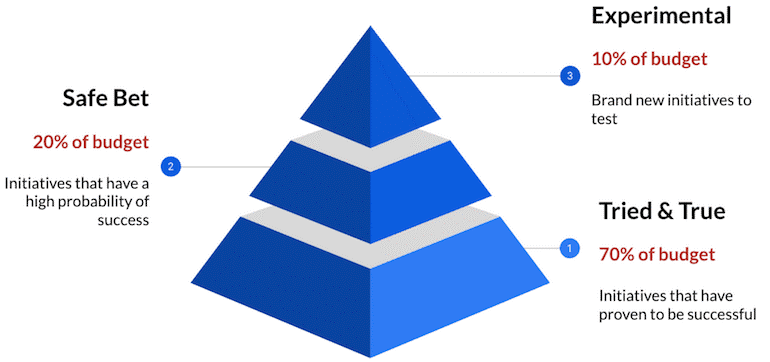Are you contriving wistfully to plan a marketing budget? Is the marketing budget for 2022 one of your top agendas? Or you may be gobsmacked with the whole “How to plan a marketing budget.” Nonetheless, read on

Let’s get out of the way: Marketing budgets don’t have to be enigmatic but demand some planning.
The article laid before you will provide invaluable information on planning a marketing budget for 2022 and tips and ideas to outshine your competitors.
Why do I need to plan a marketing budget?
First off, Good on you for thinking ahead!
Pigeonholing the planning process gives an advantage of better planning for the year ahead and ensures that marketing efforts produce the best results possible.
But when it comes down to planning a marketing budget, many companies focus their efforts on short-term results, which is a mistake. This leads to the company’s inability to yield what it needs over the long term.
Therefore, you need to be prudent regarding the marketing budget! Creating an accomplishable and data-driven budget starts with the idea of a marketing strategy to be implemented.
We have compiled nine easy-to-follow steps for creating a marketing budget with some excellent industry tips.
Ready to get planning?!
Step 1: The first thing to do is: Sit down, get rid of all the distractions, and reflect with a deep breath.
When it’s time to hammer out a budget for the next year, a strong compulsion is to start budgeting right away – perhaps copying some from last year’s budget.
Instead of going all in, why not take a little downtime and reflect on the company?
A cannier budgeting starts with recognizing areas that deserve your dollars’ attention, not the usual ones. While in this stage, ask yourself: Does my business has a brand story or a clear value proposition?”
You will be baffled by the return on a brand story and value proposition. If it is clear that both of these areas can be further improved, then do set aside some additional budget for these proceedings.
Step 2: Plan for significant events.
You might be wondering: “What are major events?”. A business’s upcoming events are the groundlaying blocks of the budget. Before you start panicking, these are simply brand refreshes, website redesigns, product launches, and live events.
A business’s significant events are non-negotiable in terms of budget allocation. They are the reason a business is moving forward.
That is why it is pivotal to factor them into the budget earlier so that more nickel-and-dime items don’t “steal” from them.
Step 3: Organize for the changes in buyers’ behavior
Are you aware that, by 2025, approximately 80% of the sales cycle will happen in digital or remote settings? This may transpire earlier than anticipated, so strategize now.
Generally, shopaholics are ready to drop dollars by the time they set up a demo with the business owner, hence need to concentrate on steering more people’s attention toward their product or service in the awareness stage and leading to more buyers’ wanting to schedule demos with the company.
At this step, you may want to ask yourself: “What drives people to buy?” using it to plan a strategy.
And this is where you have to be strategic about building your next big digital sales plan.
Furthermore, please focus on the website’s uptime 24/7 as it needs to carry the load of selling more than ever before.
Step 4: Work out marketing operations’ biggest challenges
A business or a company always has some challenges that they can’t get over. And we’re here to tell you: “That’s okay!”
Instead of repeatedly employing the same methods, hoping that someday it will fall into place and bring more leads and sales, why not take the time and reflect on those techniques?
Start by trimming off the strategies that didn’t work, making room for more nifty initiatives, and polish up the methods that could work but can’t figure out how.
Moreover, ensure that the budget spending is not heading towards “everyone else is doing it.” Cut it loose if it is gobbling up the resources and not producing results!
Remember to start studiedly by doling out more spending on solvable challenges.
Step 5: Be well-planned, not tactical
If you have played monopoly, you know that oranges are the best investment properties. They are landed on most of the time and have a sweet ROI.

To win, players lay plans to purchase advantageous properties asap and build relationships with fellow players to try to get those beneficial properties. On the flip side, buying cheap properties may look like a clever idea, but it is an ensured defeat!
To plan a marketing budget while focusing on tactics should look like this:
- Become the No.1 platform for erudite professionals when they are exhausted and looking for a career change.
- Deliver a custom-made omnichannel experience.
- Try for an efficient product trial and on-page conversion rates by launching ecosystems based on customer success touchpoints.
Hence, always align the budget to the strategy –not the other way around.
Step 6: Choose the mediums for your business
Not all divulgatory channels drive results for the business – factors like the industry and niche affect some tracks better than others.
The chosen channels for content marketing strategy should be customized according to the company!
If unsure of the channels to go with, ask yourself these questions:
- Do we require an outreach?
- Should I be focusing on certain audience groups based on their demographics?
- Is it an inbound marketing strategy?
- Will it be profitable to target specific audience groups based on keenness and behaviors?
- What are my goals: “Awareness or conversions?”.
After addressing these questions, you will be closer to determining the channels best for the business.
Step 7: Use the 70/20/10 rule on the marketing budget
The amount spent is not as weighty as how it has been paid!
It is understandable to be stalling when it comes to releasing funds, especially transferring it to outside agencies deciding where it gets spent. Indeed, we all prefer an agency or fractional CMO that is trustworthy.
There will always be finite resources to engage in campaigns and initiatives. Therefore, it is imperative to have those stockpiles funneled into programs that drive maximum results in a given marketing budget.
If you are looking towards simplifying the marketing budget, check out the 70/20/10 rule below:

Step 8: Keep the marketing budget adaptable and stay welcoming to new ideas
Generally, those in control of a large budget are risk-antagonistic people. They are the ones who double-check their shoelaces, look both ways before street crossing, and obey the traffic laws at all times.
That’s why the marketing budget seems similar year in and year out. However, no two years are the same in the digital marketing world. Trends change, practices change, social media channels appear out of nowhere, and so on –it’s unforeseeable and demands constant readjustments.
But most importantly, buyers’ behavior changes. That is why businesses must invest vigorously in what works and take a calculated risks.
A great example is SEO services; when it comes to it, companies invest their budget in this area whimsically.
For instance, companies spend around $5,000 monthly on SEO services and content marketing. What if they could unlock more growth if they invested more money in SEO?
Understanding what drives leads and sales is of high priority, and assessing what drives more results is imperative when allocating more money to it.
Step 9: Be data-informed with marketing budgets
Being data-informed about marketing budgets doesn’t have to be muddled. Instead, practice this rule of thumb: “Allocate more to efforts with proven results.”
Let’s consider a paid media example:
If you spent $15,000 on Facebook Ads in a month and didn’t see any noticeable clicks, conversions, ROI, or attributes revenue. Would it be wise to run those same ads with the same budget again?
Snap out of it; it won’t
The first thing you would want to do is pause that campaign and analyze the data. Chances are you may have targeted the wrong audiences and the bad creative and positioned the products incorrectly.
That is why it is mandatory to continuously oversee the performance of marketing collateral and activities as they belong to the budget so that funds can be allocated accordingly. In other terms, pouring more gasoline doesn’t fatten the fire unless there is a flame!
Sit down and plan a marketing budget doesn’t have to be a nuisance
The marketing budget is simple and doesn’t have to feel towering. Even a limited budget should not prevent success in plan execution and business growth.
Going through the above-discussed steps, again and again, will make you more confident and put you in control of the choices that will contribute towards your marketing budget in 2022 and is also the key to a stress-free budgeting experience.
Moreover, understanding where the money is going helps get the picture of how the business operates. That’s why budget planning gives an excellent opportunity to focus on what is more important.
And we know from experience that running daily business operations and marketing simultaneously is backbreaking. So, why not get in touch and let us take this burden off your shoulders?
We promise it won’t cost you an arm and a leg, and see how our experts tailor a marketing budget for you.

